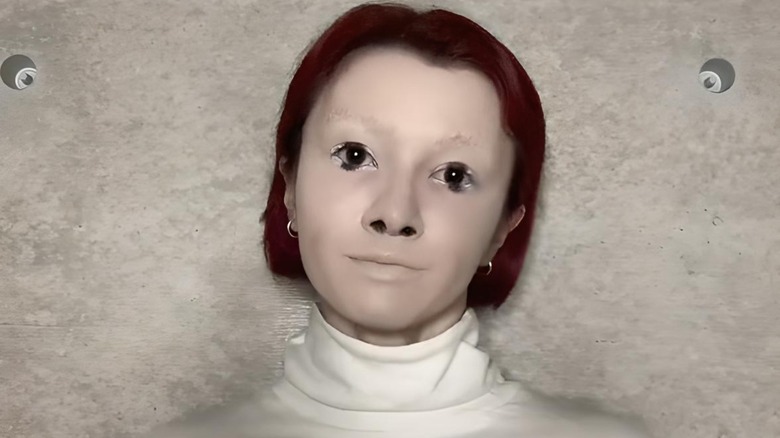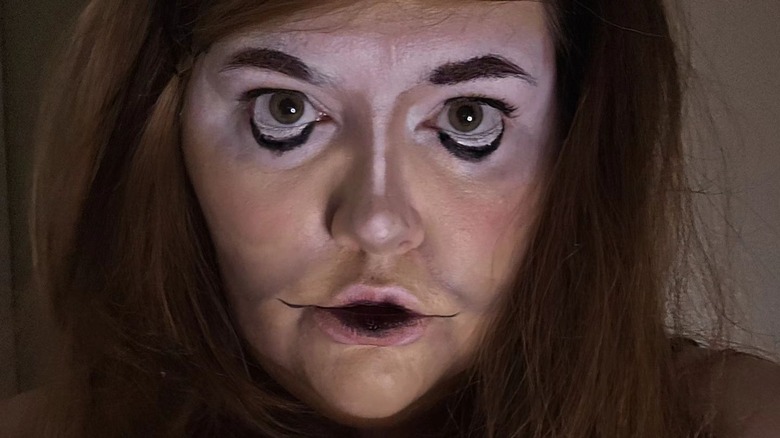TikTok's 'Uncanny Valley' Makeup Trend, Explained
When it comes to new beauty trends, TikTok is the place to make them go viral. Uncanny valley makeup is the most recent look to make the rounds and it's causing quite a stir. Before we dive into the makeup aspect, let's break down what the term "uncanny valley" means. Simply Psychology describes it as an eerie feeling people may experience when looking at a humanoid object, such as a robot or mannequin. When it resembles a person too realistically up to a certain point, it evokes feelings of disgust or fear instead of empathy. The term was first coined by professor of robotics Masahiro Mori in Japanese terms and was later translated to the English version by author Jasia Reichardt.
Now, TikTok users are attempting to recreate the feeling of uncanny valley by using makeup to resemble human-looking robots. They're applying foundation for a flawless finish and darkening around their eyes to make their pupils appear bigger. Some are even going so far as to use makeup to distort their features, like TikTok creator @magi0225 who made her mouth appear stretched out with pink lipstick. Meanwhile, @kelsiidaviess blurred out her features to look like an eerie wax figure. With so many takes on uncanny valley makeup, there are now multiple variations that you can emulate if you want to jump on this creepy bandwagon.
TikTokers share their take on uncanny valley makeup
According to NextShark, the uncanny valley makeup trend took off when TikTok user Emilia Barth shared a video of her using makeup to resemble a robot. "Attempting to subtly not look human," she wrote, while using a contour stick and concealer to over-contour her features. Many called her out for not looking completely uncanny valley and a few days later, she posted another video of herself looking like a terrifying mannequin. "Attempting to turn myself into uncanny valley," she shared. Barth seemed to have hit the mark and a fan commented, "This is the first uncanny valley makeup look I've seen that was actually unsettling, you ate this." Another wrote, "... that was the first time an uncanny valley thing actually weirded me out."
Since then, many have attempted — and succeeded at — pulling off uncanny valley makeup. Twins Evelina and Lola created haunting versions of themselves using Barth's song choice "Brutus" by The Buttress in the background. Another, who goes by Blonde Iced Cofee, shared a video of herself mouthing the words, "What? No! I am a real person," while looking creepily non-human. Although Halloween is over, makeup lovers are still creating their uncanny valley makeup looks and with a few products and tips, you can hop on this spooky trend as well.
How to do uncanny valley makeup
The trick to uncanny valley makeup is to make yourself look like a robot that is trying to look human. Confusing, right? First and foremost, you'll need to blur out your skin with heavy foundation. Many makeup gurus also cover their eyebrows and lips to redraw them later. TikTok content creator Blue Suarez used a washable glue stick to safely glue down his eyebrows and drew on very short, thin ones high on his forehead. Use a contour stick to create hollows under your cheekbones, in the inner corners of your eyes, and along your jawline. You don't want to blend too much as the contours should be evident. Dot black eyeshadow on the middle part of your upper and lower lid to make your pupils seem larger. One of the features of uncanny valley makeup is a wide mouth so use a lip pencil to extend the outer corners of your lips.
In a Reddit thread about the makeup look, which was a year ahead of the trend, users revealed that highlighting the lower lashes to make them "really long and dark" can help to achieve the aesthetic. Additionally, beginning with a pore-filling primer can create the perfect "smooth and plastic-like" base of foundation. Uncanny valley makeup isn't about precision, so have fun with it and you'll know you did a great job when you creep out strangers on the street.

